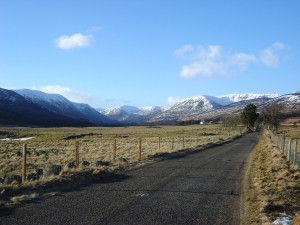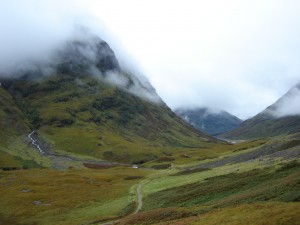Ice Age Scotland
It’s mid December, a time for rosy cheeks, winter-woollies and plenty of mulled wine; and with the snow falling thick and fast across Scotland recently it has certainly been another chilly start to the winter again. For two or three months each year the cold Arctic air blows south, bringing with it a freezing temperatures and heavy snow on the mountains; but it doesn’t last long, and by April warm spring days take over and usher in the summer. But 20,000 years ago, it didn’t as Britain like the rest of the Northern Hemisphere was gripped by a deep and lasting Ice Age; which today we only get the briefest taste of in the darkest days of winter.
The Ice Age was more than just a never ending cold, or ice building up and flowing across the landscape; it carved that very landscape, obliterating what went before and providing a new canvass for nature to re-conquer once the glaciers finally melted. The geology of Scotland in places is billions of years old, and for the most part hundreds of millions of years old; but it has been sculpted over the last two million by repeated glacial episodes, the last of which began around 30,000 years ago and finally ended 10,000 years ago. But, what causes these events and what legacy have they left us?
The principal reasons that the earth experiences enhanced ice age events periodically are astronomical; and collectively termed the Milankovitch Cycles (named after the Serbian scientist, Milutin Milanković, who first made the connection). We assume that the planet meanders through the vastness of space in a uniform manner, fixed in place: but not so. Over time periods we cannot comprehend the earth wobbles about and shifts its patterns of orbit and rotation; and does so cyclically, repeating the pattern across the ages.
Each cycle has its extremes, and can individually trigger enhanced ice growth; but they peak at differing time intervals, and so it’s only when they click together that the results can be truly spectacular. They’re not the only factors involved, others include the strength or non-existence of the Gulf Stream, plate tectonics and mountain building, and many more – and to be honest we really don’t know how it all connects together. Still, 30,000 years ago, the Milankovitch cogwheels clicked into place and the Gulf Stream turned off; resulting in the rapid build up of ice at the poles and the southward advance of the polar front: the summer limit of pack-ice.
Initially as the polar front moved southward, Scotland experienced extremely cold winters, somewhat like Canada today; resulting in glacier ice forming in the Northwest Highlands, the Nevis Range, the Cairngorms and Lochnagar; plus winter sea ice probably reached as far as the Shetland Islands. This is colder than we’ve experienced in the last 10,000 years, but there was no respite and the mercury continued to drop. Ice ages don’t happen because of cold winters, they happen because of cold summers, where the ice and snow from the previous season doesn’t melt and it builds up, layer upon layer, until it starts flowing under its own weight towards the sea via a path of least resistance. The glaciers then pool in lower ground.
It would only take a couple of thousand years to go from small glaciers in the mountains to ice caps forming in places like Rannoch Moor, Royal Deeside and the Great Glen. Around 25,000 years ago large glaciers, the like we’d associate with Alaska today would be flowing steadily down our main valleys, to perhaps a thickness of 2000ft in the upland areas. By now there is glacier ice in the Southern Uplands, the Lake District, Yorkshire and Snowdonia; and large ice flows streaming through the Central Belt mainly towards the North Sea via Strathmore and the Forth Valley.
The glacial maximum came around 18,000 years ago, when the polar front which today is to the north of Iceland reached to Portugal. Scotland was now buried under an ice-sheet over 4000ft thick in places: akin to Greenland today; and it was small in comparison. The whole of Scandinavia was buried under a much thicker dome centered over the Baltic Sea, and North America groaned under the vast weight of the Laurentide Ice Sheet, which may have been 10,000ft thick, and was over half as big again as the Antarctic sheet today. The result of all this water locked away as ice was a severe drop in sea levels: over 400ft lower than today. The North Sea didn’t was a meadowland, grazed by mammoths and other lost fauna during the short summer season. It is possible that people followed the game on to the plains; but we also know that the population of Europe was very low, and forced into cluster ‘refuges’.
From around 18,000 years ago the earth slowly warmed again and the cogs came out of sync; and by 13,000 years ago the British ice sheet, which had stretched to the English Midlands, and covered most of Ireland had gone. The ice itself had carved out a new landscape, digging deep into the rock as it ground its way to the sea. The picturesque fjord landscape of the west coast, deep valleys like Glencoe and Glen Muick, the rounded hills of the Southern Uplands and the sharp ridges of the Cuillin of Skye: all sculpted out of the bedrock by the sheer power of the glaciers. The melting of that ice had no less a dramatic effect either.
Most of the Highland valleys and all of the Lowlands are blanketed in debris either left directly by retreating ice, or washed out by meltwaters. Torrential flooding and reworking of sediment created terraces, gravel fans and deep, sandy deposits; in other places the retreating ice can be mapped by way of the unique landforms left behind, like the horseshoe shaped moraines dumped at the front of the glacier. Only the far northwest, where the landscape was heavily scoured, saw little deposition – giving us a glimpse of the immediate post glacial world of Scotland 13,000 years ago. But everywhere you look you will find evidence of Scotland’s Ice Age: from Edinburgh’s Royal Mile to the deep lochs of the Great Glen; and from the macro to the micro.
Global temperatures dropped again around 11,500 years ago, and there was further ice growth in the Highlands, but by 10,000 years ago the last of the glaciers had melted; and thus it has remained. A new world emerged from the grip of the big freeze, great rivers now flow where ice once ruled, and soon forests and grasslands came to dominate. The sea also rose, rapidly and to levels higher than today. This is thanks to a phenomenon where the land, having been compressed by the sheer weight of the ice, rebounds, but at a slower rate than the sea. So, relative to one another the sea reaches a certain height, and then the land slowly rises out of it. And all around our coast are archaic cliffs and raised beaches: testament to an older shoreline when sea levels were over 100ft higher. Scotland continues to rise.
For 10,000 years humankind has basked in the warmth of the current inter-glacial and flourished like never before in our history. But, eventually the Milankovitch cogwheels will click once more, and Scotland along with half the globe will be plunged again into the abyss of an Ice Age.
This article was written by David McNicoll, the owner of Vacation Scotland; a travel company specialising in tours and vacation packages to Scotland. If you are interested in exploring Scotland’s landscapes, please contact them by clicking their website – www.vacationscotland.biz
Tagged












